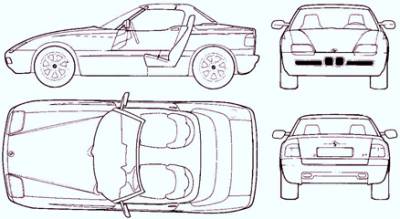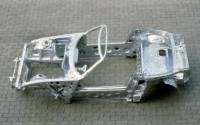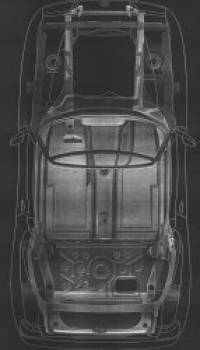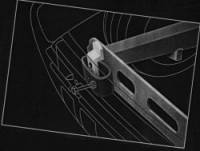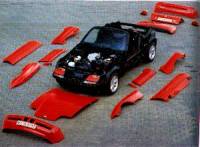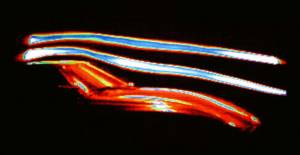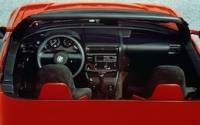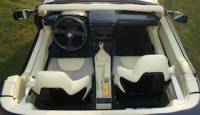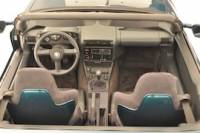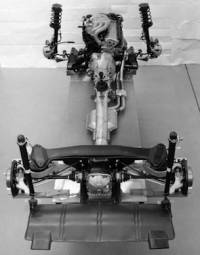Table of Contents
Inception
BMW unveiled the 154.4inch Z1 to the international community in 1988 in the Italian town of Punta Ala, the BMW 507 from the late 1950s was the last time the BMW model range included a two-seater sports car. The BMW Board of Management came up with the idea of creating a cutting-edge company that would be independent from all other development departments, a team of highly skilled engineers, technicians and designers with free rein to work on turning their best creative concepts into reality themselves, called BMW Technik GmbH, known internally simply by the letters ZT. The 60-strong team delivered concepts designed to inject car manufacture with new impetus, employing new materials, using different types of vehicle structure and shortening development times, the Z1 was born. The BMW Board of Management gave the green light for production and 12 months later the first roadworthy prototype was ready. On 1 August 1986, BMW went public and announced: “BMW Technik AG has completed its first product. The BMW Z1, a vehicle study, was conceived on the basis of specifications which build on longstanding BMW traditions at the same time as factoring in future mobility requirements.”
BMW press release stated: “BMW Technik was commissioned by the Board of Management of BMW AG to devise and execute a vehicle concept which would largely satisfy the desire for ‘freedom on four wheels’, driving pleasure and performance.” The fundamental driving experience should clearly take precedence, rather than adopting the comfort-focused approach that prevailed in competitors’ sports car concepts throughout the 1980s. “Young”, “dynamic” and “brash” should be the words that best described the Z1, along with “a new dimension in driving”. Trademark BMW roadster attributes were adopted and fused with the latest technology. Ingredients included superior performance, the ability to drive with the roof down, a sense of sheer originality and a dash of extravagance. The Z1 had all the right credentials: low weight and low centre of gravity, front mid-engine and compact dimensions. The highlight though was without doubt its pioneering technology: the unique vertical sliding door concept and the supporting sheet-metal structure with a plastic outer skin.
The roadster was to be built. It was obvious that the Z1 would have to be built largely by hand on account of its unusual design characteristics and the materials used. This, in turn, meant a small production run and a high price tag.
Two years after finalising the Z1 concept and one year on from the study’s unveiling, BMW made the following announcement on 10 August 1987: “The time for speculation is over, the guessing game has come to an end: BMW AG will be presenting the Z1 Roadster at the Frankfurt Motor Show.” Speeding up the development process had been a pilot task for this project, and after a development time of just three years a limited number of the 170 hp front mid-engined sports car would go into small-scale production from June 1988. “Once the custom-built production process is up and running at full capacity, up to six car enthusiasts a day will be able to start enjoying undiluted driving pleasure instead of just dreaming about it.” The Director of BMW Technik GmbH at that time, Ulrich Bez, gave an emphatic demonstration of the benefits of the plastic panelling: he jumped with both feet onto a vehicle wing lying on the floor, which promptly buckled – then sprang back to its original shape when he stepped off it again.
At BMW’s historic 1987 Frankfurt Motor Show: First Z Roadster, the avant-garde Z1, the first BMW roadster for around 30 years. Set off to stunning effect by a wall of water as a backdrop. With the groundswell of Euphoria, a motoring magazine attempted to buy the Reed Green exhibit straight off the stand, offering DM 150,000 in cash, which was firmly rebuffed, it was simply not possible as the Z1 was just one of ten test vehicles, all of which were still urgently required to undergo homologation testing. It was autumn 1988 before the Z1 went into production, with an asking price of DM 80,000, the potential clientele could seek solace in the first sales brochure entitled “For sheer driving passion: the BMW Z1 High-Tech Roadster”. In October 1988, Dr Wolfgang Reitzle, Member of the Board of Management responsible for Research and Development at BMW AG, saw the roadster as far more than just another new model. More importantly, it bore out the success of the innovative development structure deployed at BMW: “As a result of the newly created interdepartmental work processes that have been implemented with our Research and Technology Centre in association with Motorsport GmbH and Technik GmbH, BMW now has unique and highly efficient instruments at its disposal for the development of new cars. The Z1 represents the first project where BMW has ventured beyond a pure vehicle project to test out and successfully employ revolutionary new approaches in this broader form.”
Construction
A self-supporting monocoque construction made up of individual sheet-steel parts constituted the car’s backbone, which once welded together, the entire frame was hot-dip galvanised in an immersion bath. This ensured seamless corrosion protection for the monocoque and made it substantially more rigid. The coating of zinc that was applied acted as a connecting and supporting element, especially around panel seams and joint overlaps. The effect was an increase in the monocoque’s torsional resistance of around 25 per cent.
Floor Assembley
The vehicle floor was bonded to the frame and bolted to the Z1 bodyshell and uniquely, made of plastic. In collaboration with specialists from MBB (Messerschmitt Boelkow Blohm), the Z1 engineers developed a material which combined low weight with high load-bearing capacity, was immune to corrosion, safe in a collision, and produced smooth underbody contours. The solution was a combination of fibre-composite materials sandwiched together. The resulting structure of two layers of glass fibre-reinforced epoxy resin with polyurethane foam in between produced a floor assembly with a weight of just 15 kilograms.
This construction had the added advantage that the floor unit could be preassembled separately before being completely bonded with the vehicle frame as well as bolted to the steel structure at certain points. Special bracing incorporated into the sandwich structure enabled high forces to be applied in the vicinity of chassis mounting points and seat mountings, for instance. Indeed, the floor assembly increased the monocoque’s static torsional resistance by a further ten per cent when installed.
Safety
With the additional help of the high, oversized side sills and the engine mounts, this structure stood out for its exceptional strength and outstanding accident safety. A transverse tube in the dashboard area combined with the tube used to reinforce the windscreen frame to ensure highly effective protection in the event of a side-on collision, too. And as the tube inserted into the windscreen frame formed a direct connection between the two A-pillars, it also doubled as roll-over protection.
Outer Shell
Although roadworthy, the monocoque was draped in plastic, the Z1 being the first model ever to feature a plastic exterior whose vertical parts were all made of injection-moulded thermoplastics. Resilient and immune to damage, the panels were bolted into place. In theory, it is possible to swap all the panels in a matter of hours to any other colour.
Different types of plastic were used for the panelling parts depending on their task. The front wings, rear quarters, doors and side sills were made from a high-tech thermoplastic that was renowned for its high impact strength, almost completely eliminating the risk of bumps and dents resulting from minor knocks. The front and rear bumpers were made from a highly elastic plastic, designed to fully regain its former shape following impacts at up to 4 km/h (2.5 mph).
The bonnet, boot lid, and soft-top compartment cover were made from special fibre composites. During the production of these plastic components, different glass fabrics (depending on the demands that would be placed on the component), foam core sections as well as the necessary fastenings, such as bolts and braces, were placed into the mould in a dry state. Once the mould had been closed, epoxy resin was injected into it and compressed while being subjected to carefully controlled temperature sequences. Components manufactured in this way combined excellent surface quality and high strength with precisely defined energy absorption in the event of an accident. Despite these advantages, the BMW engineers acknowledged that “it would appear impossible in the foreseeable future to use a larger amount of plastic for making the exterior of mass-produced vehicles”.
Varioflex Paint System
A special paintwork system with three different degrees of hardness. The four possible paint finishes for the Z1 were not mere colours bearing the highly descriptive names of nature Green metallic, Dream Black metallic, Fun Yellow and Top Red, their chemical composition was different too. Development work carried out in collaboration with the suppliers had led to the creation of the Varioflex paintwork system, which catered to all the requirements when applying the paint to different plastic materials.
The conventional painting techniques for metal at that time hardly placed any special requirements on the paint in terms of its flexibility, as it was relatively easy to obtain a high surface gloss and keep the colour consistent. Due to the differing requirements depending on the specific component involved, the various plastic materials used on the Z1 called for a paintwork system offering three different levels of flexibility. High flexibility for the bumper and side sills. Medium flexibility for the doors and wings.
A hard coating of paint applied to the Bonnet, Boot lid and Soft-Top cover, as applied to a Metal body. All components received the same base coat providing the actual colour of the car, the parts were then painted with different clear coats, depending on the degree of elasticity required.
Sliding Doors
These retracted electrically into the side sills, allowing both driver and passenger to cruise along with the door open, legally and safe, with its advanced side protection and high sills, a feature which has never been emulated since. The mechanism for the doors and side windows are driven by two electric motors and a toothed belt. The motors incorporated a freewheel function to allow the doors and windows to be operated manually if necessary.
To avoid burdening the actual door with additional weight, all of the electrical and mechanical components were integrated in the car’s body. A double mechanical lock design restricted excessive door movement and prevented noise whilst driving. The windows can be operated independently or they automatically return to their original position when the door is closed, courtesy of its 'memory'.
Aerodynamics
The flat front end of the Z1, the smooth transitions on its bonnet and the windscreen raked at an angle of 62° provided all the right ingredients for a smooth flow of air along the top of the car. The vehicle’s perfectly smooth underbody formed a virtually continuous surface extending from the front end through to the rear axle. The underside of the vehicle rose slightly towards the rear in the form of a diffuser, thereby directing the airflow at the transverse rear silencer, which was shaped in the form of a wing to help reduce rear axle lift.
Styling
The Z1 marked a departure from the long, elongated shape of classic roadsters, featuring instead short overhangs as well as a compact overall length relative to its wheelbase. The joints along the side panels were quite different from the conventional designs at that time.
The new door concept produced a wide, joint-free side sill with an elevated entrance height, with the upper edge of the bumpers and side sills forming a continuous line. The Z1 was tapered in around the doors, giving the wings a broad and flared appearance that was reminiscent of the M3. The BMW kidney grille also sported an updated look, as it was fully integrated in the front bumper’s contours, making it look smaller and more compact.
Interior
The new BMW roadster’s interior appointments were highly functional, the seats and door panels were all trimmed in new high-class materials combined with fine leather. The low-slung seating position, bulky transmission tunnel and wide sills called for a new technical concept for the Z1 seats, so the roadster was fitted with bucket-shaped all-foam seats affording the high levels of lateral support needed to be able to put the sports car’s outstanding cornering abilities to the test.
Plastic shells painted to match the car’s colour enveloped the seat backrest, which had the headrest integrated into its outline. The driver’s seat was height adjustable, and the passenger seat could be tilted forward to make better use of the through-loading facility and gain access to the discreetly located safe-like lockable glovebox.
Suspension
Low centre of gravity, broad stance, the powertrain and chassis of the Z1 were largely E30 components. Hard at work under the bonnet was the classic BMW straight-six engine, which mustered 170 hp from its 2.5-litre displacement and was fitted in a front-mid position. A central aluminium tube ran from the five-speed manual gearbox to the rear differential to produce a torsionally and flexurally rigid link between the two. The single-joint spring-strut front axle taken from the 3 Series handled the task of wheel location at the front, but a brand new construction was employed at the rear: a multi-link axle comprising two transverse control arms and one longitudinal control arm. It was dubbed the “Z-axle” in German, which was shorthand for “centrally guided, spherical double-wishbone axle” rather than a reference to the new model’s name. The kinematic arrangement of the three control arms ensured excellent directional stability as well as effective anti-squat and anti-dive control. This configuration endowed the Z1 with go-kart-like handling characteristics, with the axle load split in the ratio 49:51 and the vehicle’s centre of gravity located some ten centimetres lower than on comparable models.
More on Suspension
Driven
During the launch, the assembled car testers noted that the poorer roads were no trouble for the chassis or provoke any tangible body torsion. The Z1 had a top speed of 140 mph with a 0 - 60 under eight seconds. One tester reported, “it is not the performance that makes the car so appealing, it is the way it drives. Nimble like a go-kart, instantaneous throttle response, goes round bends as if it’s on rails, it fits the driver like a glove, making it so much fun to drive. The sensation generated by the raw motoring experience is further heightened by the fact that you are virtually sitting out in the open air, it’s like a motorcycle on four wheels.”
Marketing
The roadster’s advertising campaign featured the first fully computer-animated product film from BMW, a real-life couple in an actual Z1 gliding through a virtual world for five and a half minutes, wearing the original soft white leather balaclavas that BMW had specially made for the Z1. In 1990 BMW Motorsport GmbH offered the first “Z1 adventure tour” to the south of France, comprising an all-inclusive experience that would be enjoyed “with kindred spirits and in the most exclusive style”: three days in the south of France, a flight in a helicopter, powering around the Paul Ricard grand prix circuit near Marseilles with a chance for participants to hone their driving skills, staying in smart sport hotels.
The total price of DM 3,500 even included the Z1 that was provided for the event. A few months later, in spring 1991, the artist A.R. Penck adorned a Top Red Z1 with black graffiti, thereby adding a new member to the legendary series of Art Cars. Another bright red Z1 was destined to stay in the garage though: a roadster boasting a wide, sporty chassis and an uprated engine under the bonnet, the Z1 M was a prototype model from Motorsport GmbH sporting muscular wheel arches, a low-slung front end and twin headlights. Two air scoops arched behind the head restraints, and sitting atop either side of the deep rear apron were two pairs of circular rear lights. In short, the graceful roadster had been transformed into a beefy racer.
Production Run
A run of just 8,012 were produced between March 1989 and June 1991 designed by Harm Lagaay. 66 of which were officially released by Alpina as the RLE Roadster Limited Edition. The first 4 colours were released between 1989 and 1990, then 2 more schemes were added in 1991.
- 133 - FunGelb (Yellow)
- 2301 - Traumschwarz (Dream Black)
- 3105 - Toprot (Top Red)
- 2040 - Urgren Metalic (Metallic Green)
- 193 - Pur-Blau (Pure Blue)
- 228 - Magic Violet Metalic (Purple)
It has been reported that 2 cars were produced in GRAU, DEUNKEL GRAU (Gray), AL03043 and AL07393, the latter an RLE in Japan.
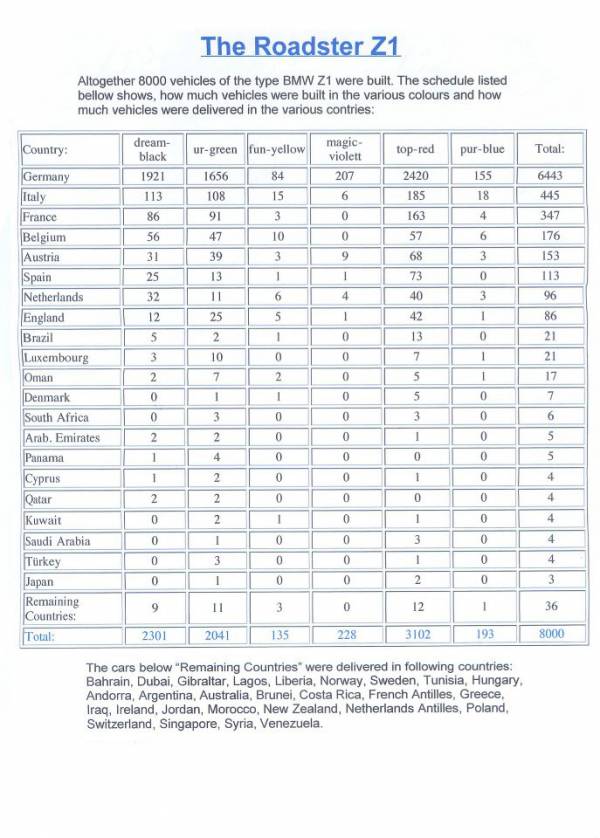
Price
The price for the Z1 climbed to DM 83,000, with 4,000 orders placed, when the first production models rolled off the assembly line in early 1989, sales contracts were found in newspapers for a premium of DM 20,000.
2014, prices have remained largely unchanged for a number of year, selling between £17k - £24k.

